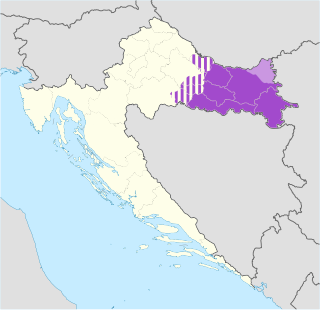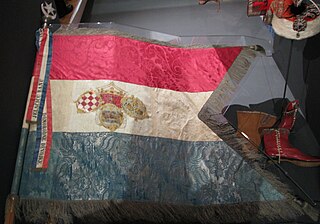
At the time of the Roman Empire, the area of modern Croatia comprised two Roman provinces, Pannonia and Dalmatia. After the collapse of the Western Roman Empire in the 5th century, the area was subjugated by the Ostrogoths for 50 years, before being incorporated into the Byzantine Empire.

Slavonia is, with Dalmatia, Croatia proper, and Istria, one of the four historical regions of Croatia. Located in the Pannonian Plain and taking up the east of the country, it roughly corresponds with five Croatian counties: Brod-Posavina, Osijek-Baranja, Požega-Slavonia, Virovitica-Podravina, and Vukovar-Syrmia, although the territory of the counties includes Baranya, and the definition of the western extent of Slavonia as a region varies. The counties cover 12,556 square kilometres or 22.2% of Croatia, inhabited by 806,192—18.8% of Croatia's population. The largest city in the region is Osijek, followed by Slavonski Brod and Vinkovci.

The national flag of Croatia or The Tricolour is one of the state symbols of Croatia. It consists of three equal size, horizontal stripes in colours red, white and blue. In the middle is the coat of arms of Croatia.

The Croatian Parliament or the Sabor is the unicameral legislature of Croatia. Under the terms of the Croatian Constitution, the Sabor represents the people and is vested with legislative power. The Sabor is composed of 151 members elected to a four-year term on the basis of direct, universal and equal suffrage by secret ballot. Seats are allocated according to the Croatian Parliament electoral districts: 140 members of the parliament are elected in multi-seat constituencies. An additional three seats are reserved for the diaspora and Croats in Bosnia and Herzegovina, while national minorities have eight places reserved in parliament. The Sabor is presided over by a Speaker, who is assisted by at least one deputy speaker.

The Croatian Peasant Party is an agrarian political party in Croatia founded on 22 December 1904 by Antun and Stjepan Radić as Croatian Peoples' Peasant Party (HPSS). The Brothers Radić believed that the realization of Croatian statehood was possible within Austria-Hungary, but that it had to be reformed as a Monarchy divided into three equal parts – Austria, Hungary, Croatia. After the creation of Kingdom of Yugoslavia in 1918, Party requested for the Croatian part of the Kingdom to be based on self-determination. This brought them great public support which culminated in 1920 parliamentary election when HPSS won all 58 seats assigned to Croatia.

The State of Slovenes, Croats and Serbs was a political entity that was constituted in October 1918, at the end of World War I, by Slovenes, Croats and Serbs (Prečani) residing in what were the southernmost parts of the Austro-Hungarian Empire. Although internationally unrecognised, this was the first incarnation of a Yugoslav state founded on the Pan-Slavic ideology. Thirty-three days after it was proclaimed, the state joined the Kingdom of Serbia and the Kingdom of Montenegro to form the Kingdom of Serbs, Croats and Slovenes.
The Government of Croatia, formally the Government of the Republic of Croatia, commonly abbreviated to Croatian Government, is the main executive branch of government in Croatia. It is led by the president of the Government, informally abbreviated to premier or prime minister. The prime minister is nominated by the president of the Republic from among those candidates who enjoy majority support in the Croatian Parliament; the candidate is then chosen by the Parliament. There are 20 other government members, serving as deputy prime ministers, government ministers or both; they are chosen by the prime minister and confirmed by the Parliament (Sabor). The Government of the Republic of Croatia exercises its executive powers in conformity with the Croatian Constitution and legislation enacted by the Croatian Parliament. The current government is led by Prime Minister Andrej Plenković.

Syrmia County was a historic administrative subdivision (županija) of the Kingdom of Croatia-Slavonia. Croatia-Slavonia was an autonomous kingdom within the Lands of the Crown of Saint Stephen (Transleithania), the Hungarian part of Austria-Hungary. The region of Syrmia is today split between Croatia and Serbia. The capital of the county was Vukovar.

Count Károly Khuen-Héderváry de Hédervár, born as Károly Khuen de Belás was a Hungarian politician and the ban of the Kingdom of Croatia-Slavonia in the late nineteenth century. Khuen's reign was marked by a strong magyarization. After a series of riots broke out against him in 1903, Khuen was relieved of his duty and appointed prime minister of Hungary.

The Kingdom of Dalmatia was a crown land of the Austrian Empire (1815–1867) and the Cisleithanian half of Austria-Hungary (1867–1918). It encompassed the entirety of the region of Dalmatia, with its capital at Zadar.

Baron Slavko Cuvaj de Ivanska was a Croatian politician who was the Ban of Croatia-Slavonia and royal commissioner for Austria-Hungary.

The Kingdom of Croatia-Slavonia was a nominally autonomous kingdom and constitutionally defined separate political nation within the Austro-Hungarian Empire. It was created in 1868 by merging the kingdoms of Croatia and Slavonia following the Croatian–Hungarian Settlement of 1868. It was associated with the Kingdom of Hungary within the dual Austro-Hungarian state, being within the Lands of the Crown of St. Stephen, also known as Transleithania. While Croatia had been granted a wide internal autonomy with "national features", in reality, Croatian control over key issues such as tax and military issues was minimal and hampered by Hungary. It was internally officially referred to as the Triune Kingdom of Croatia, Slavonia and Dalmatia, also simply known as the Triune Kingdom, and had claims on Dalmatia, which was administered separately by the Austrian Cisleithania. The city of Rijeka, following a disputed section in the 1868 Settlement known as the Rijeka Addendum, became a corpus separatum and was legally owned by Hungary, but administered by both Croatia and Hungary.

Ban of Croatia was the title of local rulers or office holders and after 1102, viceroys of Croatia. From the earliest periods of the Croatian state, some provinces were ruled by bans as a ruler's representative (viceroy) and supreme military commander. In the 18th century, Croatian bans eventually became the chief government officials in Croatia.

The Kingdom of Croatia was part of the Lands of the Hungarian Crown, but was subject to direct Imperial Austrian rule for significant periods of time, including its final years. Its capital was Zagreb. It was also a part of the lands of the Habsburg monarchy from 1527, following the Election in Cetin, and the Austrian Empire from 1804 to 1867.
Parliamentary elections were held in the Kingdom of Croatia-Slavonia from 19 to 22 May 1897. The People's Party emerged as the victor.
Events from the year 1913 in Croatia.

The Croatian–Hungarian Settlement was a pact signed in 1868 that governed Croatia's political status in the Hungarian-ruled part of Austria-Hungary. It lasted until the end of World War I, when the Croatian Parliament, as the representative of the historical sovereignty of Croatia, decided on October 29, 1918 to end all state and legal ties with the old Austria-Hungary.

The Triune Kingdom or Triune Kingdom of Croatia, Slavonia and Dalmatia was the concept—advocated by the leaders of the 19th-century Croatian national revival—of a united kingdom between Croatia, Slavonia and Dalmatia, which were already within the Austrian Empire under one king, who was also the Emperor of Austria, but were politically and administratively separate entities. This concept had roots in the high medieval period, as a successor to the historical Kingdom of Croatia which was made up of those regions.
The Croat-Serb Coalition was a major political alliance in Austria-Hungary during early 20th century that governed the Croatian lands, the crownlands of Croatia-Slavonia and Dalmatia. It represented the political idea of a cooperation of Croats and Serbs in Austria-Hungary for mutual benefit. Its main leaders were, at first Frano Supilo and Svetozar Pribićević, then Pribićević alone.

Károly Unkelhäusser was a Hungarian politician who served as Minister without portfolio of Croatian Affairs between 1917 and 1918. From 20 December 1912 he substituted Slavko Cuvaj until the ban's definitive replacement. He was the substitute of the province chief of Bosnia and Herzegovina between 1915 and 1917, but he left this position for the Croatian Affairs ministerial post. He was deprived of his function as a result of the Aster Revolution.



















